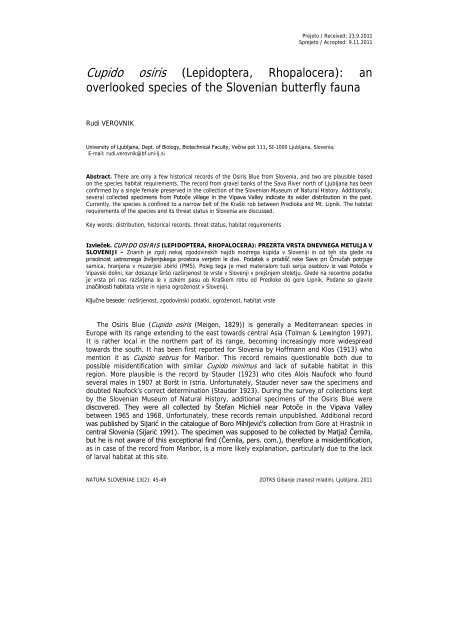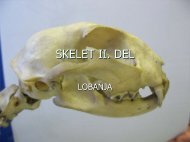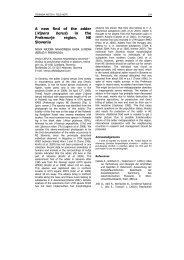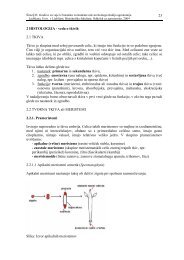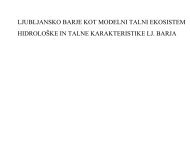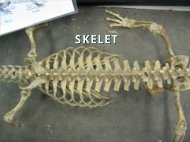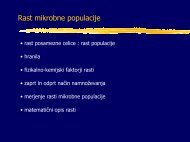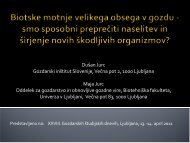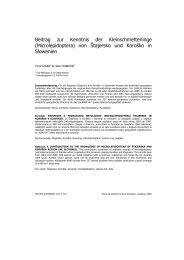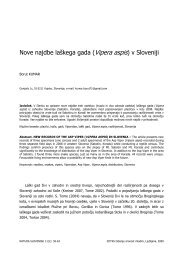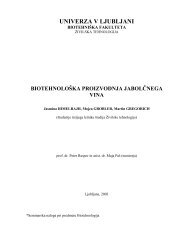Cupido osiris (Lepidoptera, Rhopalocera): an overlooked species of ...
Cupido osiris (Lepidoptera, Rhopalocera): an overlooked species of ...
Cupido osiris (Lepidoptera, Rhopalocera): an overlooked species of ...
Create successful ePaper yourself
Turn your PDF publications into a flip-book with our unique Google optimized e-Paper software.
Prejeto / Received: 23.9.2011<br />
Sprejeto / Accepted: 9.11.2011<br />
<strong>Cupido</strong> <strong>osiris</strong> (<strong>Lepidoptera</strong>, <strong>Rhopalocera</strong>): <strong>an</strong><br />
<strong>overlooked</strong> <strong>species</strong> <strong>of</strong> the Sloveni<strong>an</strong> butterfly fauna<br />
Rudi VEROVNIK<br />
University <strong>of</strong> Ljublj<strong>an</strong>a, Dept. <strong>of</strong> Biology, Biotechnical Faculty, Večna pot 111, SI-1000 Ljublj<strong>an</strong>a, Slovenia;<br />
E-mail: rudi.verovnik@bf.uni-lj.si<br />
Abstract. There are only a few historical records <strong>of</strong> the Osiris Blue from Slovenia, <strong>an</strong>d two are plausible based<br />
on the <strong>species</strong> habitat requirements. The record from gravel b<strong>an</strong>ks <strong>of</strong> the Sava River north <strong>of</strong> Ljublj<strong>an</strong>a has been<br />
confirmed by a single female preserved in the collection <strong>of</strong> the Sloveni<strong>an</strong> Museum <strong>of</strong> Natural History. Additionally,<br />
several collected specimens from Potoče village in the Vipava Valley indicate its wider distribution in the past.<br />
Currently, the <strong>species</strong> is confined to a narrow belt <strong>of</strong> the Kraški rob between Predloka <strong>an</strong>d Mt. Lipnik. The habitat<br />
requirements <strong>of</strong> the <strong>species</strong> <strong>an</strong>d its threat status in Slovenia are discussed.<br />
Key words: distribution, historical records, threat status, habitat requirements<br />
Izvleček. CUPIDO OSIRIS (LEPIDOPTERA, RHOPALOCERA): PREZRTA VRSTA DNEVNEGA METULJA V<br />
SLOVENIJI – Zn<strong>an</strong>ih je zgolj nekaj zgodovinskih najdb modrega kupida v Sloveniji in od teh sta glede na<br />
prisotnost ustreznega življenjskega prostora verjetni le dve. Podatek s prodišč reke Save pri Črnučah potrjuje<br />
samica, hr<strong>an</strong>jena v muzerjski zbirki (PMS). Poleg tega je med materialom tudi serija osebkov iz vasi Potoče v<br />
Vipavski dolini, kar dokazuje širšo razširjenost te vrste v Slovenji v prejšnjem stoletju. Glede na recentne podatke<br />
je vrsta pri nas razširjena le v ozkem pasu ob Kraškem robu od Predloke do gore Lipnik. Pod<strong>an</strong>e so glavne<br />
značilnosti habitata vrste in njena ogroženost v Sloveniji.<br />
Ključne besede: razširjenost, zgodovinski podatki, ogroženost, habitat vrste<br />
The Osiris Blue (<strong>Cupido</strong> <strong>osiris</strong> (Meigen, 1829)) is generally a Mediterr<strong>an</strong>e<strong>an</strong> <strong>species</strong> in<br />
Europe with its r<strong>an</strong>ge extending to the east towards central Asia (Tolm<strong>an</strong> & Lewington 1997).<br />
It is rather local in the northern part <strong>of</strong> its r<strong>an</strong>ge, becoming increasingly more widespread<br />
towards the south. It has been first reported for Slovenia by H<strong>of</strong>fm<strong>an</strong>n <strong>an</strong>d Klos (1913) who<br />
mention it as <strong>Cupido</strong> sebrus for Maribor. This record remains questionable both due to<br />
possible misidentification with similar <strong>Cupido</strong> minimus <strong>an</strong>d lack <strong>of</strong> suitable habitat in this<br />
region. More plausible is the record by Stauder (1923) who cites Alois Naufock who found<br />
several males in 1907 at Boršt in Istria. Unfortunately, Stauder never saw the specimens <strong>an</strong>d<br />
doubted Naufock’s correct determination (Stauder 1923). During the survey <strong>of</strong> collections kept<br />
by the Sloveni<strong>an</strong> Museum <strong>of</strong> Natural History, additional specimens <strong>of</strong> the Osiris Blue were<br />
discovered. They were all collected by Štef<strong>an</strong> Michieli near Potoče in the Vipava Valley<br />
between 1965 <strong>an</strong>d 1968. Unfortunately, these records remain unpublished. Additional record<br />
was published by Sijarić in the catalogue <strong>of</strong> Boro Mihljević’s collection from Gore at Hrastnik in<br />
central Slovenia (Sijarić 1991). The specimen was supposed to be collected by Matjaž Černila,<br />
but he is not aware <strong>of</strong> this exceptional find (Černila, pers. com.), therefore a misidentification,<br />
as in case <strong>of</strong> the record from Maribor, is a more likely expl<strong>an</strong>ation, particularly due to the lack<br />
<strong>of</strong> larval habitat at this site.<br />
NATURA SLOVENIAE 13(2): 45-49 ZOTKS Gib<strong>an</strong>je zn<strong>an</strong>ost mladini, Ljublj<strong>an</strong>a, 2011
46<br />
Rudi VEROVNIK: <strong>Cupido</strong> <strong>osiris</strong>: <strong>an</strong> <strong>overlooked</strong> <strong>species</strong> <strong>of</strong> the Sloveni<strong>an</strong> butterfly fauna / SHORT COMMUNICATION<br />
In recent years, the <strong>species</strong> has been known to fly near Kraški rob, but no exact records<br />
are given (Carnelutti & Tonkli 1990). There are only two specimens from Riž<strong>an</strong>a in the<br />
collection <strong>of</strong> Boro Mihljević (Sijarić 1991), which is a rather misleading information as there is<br />
no larval habitat in or around Riž<strong>an</strong>a village. The records listed below (in chronological order)<br />
are therefore the first exact information on the recent distribution <strong>of</strong> the Osiris Blue in<br />
Slovenia:<br />
• 27.5.2000 – along the path on SE slopes <strong>of</strong> Vrh hill above Hrastovlje; coordinates:<br />
45°30'35''N, 13°53'52''E; Verovnik, R.<br />
• 17.5.2001 – grassl<strong>an</strong>d along the road to Brezovica at the source <strong>of</strong> Riž<strong>an</strong>a River;<br />
coordinates: 45°31'30''N, 13°53'16''E; Verovnik, R.<br />
• 1.6.2002 – road verge along the Predloka-Loka road, 250 m W <strong>of</strong> Predloka; coordinates:<br />
45°32'25''N, 13°53'03''E; Verovnik, R.<br />
• 23.5.2003, 9.6.2006 – along the path in a small valley <strong>of</strong> Hrastovski potok, S <strong>of</strong> Hrastovlje;<br />
coordinates: 45°30'01''N, 13°53'55''E; Verovnik, R.<br />
• 9.6.2006 – grassl<strong>an</strong>ds along the road to Z<strong>an</strong>igrad, 500 m N <strong>of</strong> village Dol pri Hrastovljah;<br />
coordinates: 45°30'23''N, 13°54'38''E; Verovnik, R.<br />
• 10.6.2006 – grassl<strong>an</strong>ds on the upper terrace below Mt. Lipnik, N <strong>of</strong> Rakitovec village;<br />
coordinates: 45°30'23''N, 13°54'38''E; Kogovšek, N.<br />
• 11.6.2006 – grassl<strong>an</strong>ds on the slopes S <strong>of</strong> Hrastovlje village; coordinates: 45°30'19''N,<br />
13°53'58''E; Kosmač, M.<br />
• 24.5.2008, 15.5.2009, 21.5.2009 – small gully along the road W <strong>of</strong> Hrastovlje village;<br />
coordinates: 45°31'24''N, 13°53'27''E; Verovnik, R.<br />
• 24.5.2008 – small glade on the path bellow the wall <strong>of</strong> Štrkljevica hill, 200 m NW <strong>of</strong><br />
Z<strong>an</strong>igrad village; coordinates: 45°30'59''N, 13°54'28''E; Verovnik, R.<br />
• 24.5.2008, 1.5.2011 – grassl<strong>an</strong>ds on Podračje hill, N <strong>of</strong> Hrastovlje village; coordinates:<br />
45°31'07''N, 13°54'00''E; Verovnik, R.<br />
• 21.5.2009 – stony grassl<strong>an</strong>ds on S slopes <strong>of</strong> Na Reti hill, N <strong>of</strong> Hrastovlje village;<br />
coordinates: 45°31'00''N, 13°54'16''E; Verovnik, R.<br />
• 21.5.2009, 17.5.2011 – along the path to Podračje hill from Hrastovlje village; coordinates:<br />
45°31'00''N, 13°54'13''E; Verovnik, R.<br />
• 1.5.2011 – grassl<strong>an</strong>ds between the main road <strong>an</strong>d the Hrastovski potok, N <strong>of</strong> Hrastovlje<br />
village; coordinates: 45°31'15''N, 13°53'44''E; Verovnik, R.<br />
• 17.5.2011 – at the bridge over Hrastovski potok bellow Hrastovlje village; coordinates:<br />
45°30'43''N, 13°54'14''E; Verovnik, R.<br />
• 17.5.2011 – along railway lines bellow Podpeč village; coordinates: 45°31'14''N,<br />
13°54'03''E; Verovnik, R.<br />
The Osiris Blue was currently observed at 15 sites in Slovenia, mostly concentrated around<br />
Hrastovlje village bellow Kraški rob. Kraški rob forms the boundary between the Kras plateau<br />
<strong>an</strong>d the flysch hills in the coastal part <strong>of</strong> Slovenia. Due to southern exposition, it is one <strong>of</strong> the<br />
warmest parts <strong>of</strong> Slovenia with typical xerophilous vegetation. This concentration <strong>of</strong> locations<br />
indicates a possibly contiguous distribution <strong>of</strong> the <strong>species</strong> in this part <strong>of</strong> Kraški rob, with<br />
displaced record at Predloka, indicating its potential wider distribution. The most outst<strong>an</strong>ding<br />
record is from Mt. Lipnik (Kogovšek, pers. comm.) about 5 km away towards SE. The butterfly<br />
was found in dry grassl<strong>an</strong>d at the altitude <strong>of</strong> 700 m, which is about 500 higher th<strong>an</strong> all the<br />
other known sites in Slovenia. Whether this is <strong>an</strong> exceptional record <strong>of</strong> a blown away<br />
specimen, or a perm<strong>an</strong>ent population, remains to be verified.
NATURA SLOVENIAE 13(2): 45-49 47<br />
The habitat <strong>of</strong> the Osiris Blue is well characterized by the presence <strong>of</strong> larval host pl<strong>an</strong>ts<br />
Sainfoins (Onobrychis spp.). These are relatively widespread on Kraški rob, however, adults <strong>of</strong><br />
Osiris Blue have been found mostly in a more disturbed habitat, especially along roads <strong>an</strong>d<br />
paths where Sainfoins flower in abund<strong>an</strong>ce. Additionally, they were found also in rocky or<br />
open s<strong>an</strong>dy areas, <strong>an</strong>d only rarely in open grassl<strong>an</strong>ds. Adults were mostly observed nectaring<br />
on different flowers including the Sainfoins. Although imbibing minerals on wet soils is<br />
common in blues, it was observed only once in Osiris Blue during recent surveys in Slovenia.<br />
Adults are usually present in low densities with commonly only single specimens observed at<br />
the site. In the last three years, the butterfly seems to have been more widespread, but<br />
maintains to be observed in low numbers. It flies only in a single generation from beginning <strong>of</strong><br />
May until mid June. Specimens <strong>of</strong> the second generation commonly observed further south<br />
have not been recorded so far.<br />
Figure 1. The recent distribution (records after year 1999) <strong>of</strong> the Osiris Blue (<strong>Cupido</strong> <strong>osiris</strong>) in Slovenia.<br />
Slika 1. Recentna razširjenost (podatki po letu 1999) modrega kupida (<strong>Cupido</strong> <strong>osiris</strong>) v Sloveniji.
48<br />
Rudi VEROVNIK: <strong>Cupido</strong> <strong>osiris</strong>: <strong>an</strong> <strong>overlooked</strong> <strong>species</strong> <strong>of</strong> the Sloveni<strong>an</strong> butterfly fauna / SHORT COMMUNICATION<br />
The <strong>species</strong> is listed as end<strong>an</strong>gered (E) in Sloveni<strong>an</strong> Red List (Uradni list 2002) due to the<br />
severe contraction <strong>of</strong> its r<strong>an</strong>ge <strong>an</strong>d the specific nature <strong>of</strong> its larval habitat. Definitively its low<br />
abund<strong>an</strong>ces indicate that the habitats for the <strong>species</strong> in Slovenia are suboptimal, possibly due<br />
to climatic conditions <strong>an</strong>d sparseness <strong>of</strong> suitable larval microhabitat. Certainly this is the key to<br />
underst<strong>an</strong>ding the threat status <strong>of</strong> the <strong>species</strong>; however, nothing is known on the larval<br />
ecology in Slovenia. In general, the ab<strong>an</strong>donment <strong>of</strong> grassl<strong>an</strong>ds including the infrastructure<br />
(paths <strong>an</strong>d roads) does pose the biggest threat in the long term, as larval host pl<strong>an</strong>t will<br />
become less abund<strong>an</strong>t <strong>an</strong>d widespread. It remains to be seen how the climatic ch<strong>an</strong>ges will<br />
affect the Osiris Blue in Slovenia along the northern boundary <strong>of</strong> its distribution in the region.<br />
Povzetek<br />
Modri kupido je v Evropi razširjen pretežno v Mediter<strong>an</strong>u. Za Slovenijo je zn<strong>an</strong>ih le nekaj zgodovinskih<br />
najdb, ki pa razen v enem primeru niso preverljive. Vsekakor je vrsta nekoč živela v Vipavski dolini in na<br />
prodiščih Save v Ljublj<strong>an</strong>ski kotlini. Recentni podatki so omejeni na območje Kraškega roba od Predloke<br />
do gore Lipnik. Tu je večina lokalitet skoncentrir<strong>an</strong>a v okolici Hrastovelj, kar verjetno ponazarja sklenjeno<br />
razširjenost te vrste pri nas. Tudi podatek iz Predloke bi lahko šteli v območje sklenjene razširjenosti,<br />
nikakor pa ne najdbe na pobočjih gore Lipnik, kjer je bil metulj najden skoraj 500 m višje kot na drugih<br />
lokalitetah. Ponovitev te najdbe bi bila vsekakor zaželena.<br />
Vrsta je v Sloveniji vez<strong>an</strong>a na suha skalnata območja, poti in kolovoze, kjer deloma tudi na golih tleh<br />
uspeva larvalna gostiteljska rastlina, turška medena detelja (Onobrychis spp.). Ta je tudi pomemben vir<br />
nektarja za modrega kupida. Vrsta se pri nas pojavlja v nizkih gostotah, večinoma so opaženi le<br />
posamezni primerki na lokaliteto. To je verjetno odsev suboptimalnih klimatskih razmer in pom<strong>an</strong>jk<strong>an</strong>ja<br />
ustreznega larvalnega mikrohabitata. Žal o larvalni biologiji vrste, ki je ključna za razumev<strong>an</strong>je njene<br />
ogroženosti, v Sloveniji ne vemo nič. V splošnem pa velja, da je glavni dejavnik ogrož<strong>an</strong>ja opušč<strong>an</strong>je<br />
košnje suhih skalnatih travišč in infrastrukture (poti, kolovozi), ki vodi v zarašč<strong>an</strong>je in izgubo rastišč<br />
gostiteljske rastline.<br />
Acknowledgments<br />
The author would wish to th<strong>an</strong>k Nika Kogovšek <strong>an</strong>d Marko Kosmač for providing their records <strong>of</strong> Osiris Blue.
NATURA SLOVENIAE 13(2): 45-49 49<br />
References<br />
Carnelutti J., Michieli Š. (1955): Prispevek k favni lepidopterov Slovenije. Biološki vestnik 4: 43-55.<br />
Carnelutti J., Tonkli P. (1990): Metulji (<strong>Lepidoptera</strong>-Macrolepidoptera). In: Bole J., Br<strong>an</strong>celj A.,<br />
Carnelutti J., Devetak D., Drovenik B., Gogala A., Horvat B., Kos I., Krušnik C., Kryštufek B.,<br />
Mršić N., Novak T., Potočnik F., Sivec I., Sl<strong>an</strong>a L., Slapnik R., Tonkli P., Tome D., Žerdin M. /<br />
Krušnik, C. (Ed.), Inventarizacija in topografija favne na območju kraškega roba in območju Veli<br />
Bad<strong>an</strong>j-Krog (končno poročilo), Inštitut za biologijo Univerze v Ljublj<strong>an</strong>i, Ljublj<strong>an</strong>a, pp. 65-87.<br />
H<strong>of</strong>fm<strong>an</strong>n F., Klos R. (1913): Die Schmetterlinge Steiermarks. Mitteilungen des<br />
Naturwissenschaftlichen Vereines für Steiermark 50: 184-323.<br />
Sijarić R. (1991): Katalog naučne zbirke <strong>Lepidoptera</strong> (Insecta) donatora Bore Mihljevića iz Sarajeva.<br />
Glasnik Zemaljskog Muzeja u Sarajevu 30: 169-360.<br />
Stauder H. (1923): Die Schmetterlingsfauna der illyro-adriatischen Festl<strong>an</strong>d- und Inselzone (Faunula<br />
Illyro-Adriatica). Zeitschrift für wissenschaftliche Insektenbiologie 18(8/9): 187-20.<br />
Tolm<strong>an</strong> T., Lewington R. (1997): Collins field guide Butterflies <strong>of</strong> Britain <strong>an</strong>d Europe, HarperCollins<br />
pub., London, 104 pl., 320 pp.<br />
Uradni list RS, št. 82/02 (2002): Pravilnik o uvrstitvi ogroženih rastlinskih in živalskih vrst v rdeči<br />
seznam, Priloga 16. Ur. l. Rep. Slo. – Uredbe 82: 8893-8975.


